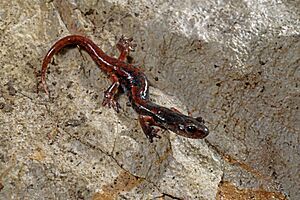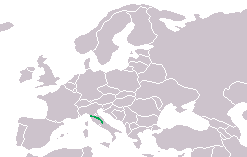Italian cave salamander facts for kids
Quick facts for kids Italian cave salamander |
|
|---|---|
 |
|
| Conservation status | |
| Scientific classification | |
| Genus: |
Speleomantes
|
| Species: |
italicus
|
 |
|
| Synonyms | |
|
Hydromantes italicus Dunn, 1923 |
|
The Italian cave salamander (Speleomantes italicus) is a special type of salamander that lives in Italy. It belongs to a family of salamanders called Plethodontidae. These amazing creatures are found only in Italy. They live in cool places like temperate forests, rocky areas, and especially in caves and other underground spots. Sadly, their homes are shrinking, which puts them at risk.
Contents
Meet the Italian Cave Salamander
The Italian cave salamander is a slim animal with short legs. It can grow to be about 12.5 centimeters (about 5 inches) long, including its short tail. Its head is wide, and its eyes stick out a bit. You can see a clear groove between its nose and the edge of its lips. Its feet are partly webbed, which helps it climb.
What Does It Look Like?
These salamanders are usually dark in color. They have cool patterns of reddish or yellowish spots all over their bodies. Their bellies are dark too. If you find one in the northern part of its home range, you might notice it has even more color variations. Sometimes, these salamanders even mix with another type called Ambrosi's cave salamander.
Where Do Italian Cave Salamanders Live?
The Italian cave salamander calls northern Italy its home. You can find it in the northern and central parts of the Apennine Mountains. Their range stretches from the Province of Lucca and Province of Reggio Emilia in the north, all the way south to the Province of Pescara.
Their Favorite Places
These salamanders love living in wooded valleys, on rocky cliffs, and deep inside caves or underground water systems. They often choose places made of limestone rock. You can find them living at high altitudes, sometimes as high as 1,600 meters (about 5,250 feet) above sea level!
Salamanders in Germany?
Believe it or not, there's also a group of these salamanders living in an old quarry (a place where rocks are dug out) near Holzminden, Germany. This group was not originally from Germany; they were brought there by people a long time ago. Scientists think they might have been there for as long as 100 years! This could be because a family in the early 1900s owned both an animal import business and several quarries in that area.
How Do They Behave and Reproduce?
Italian cave salamanders are usually found in areas with limestone rock. But sometimes, they can also live in places with sandstone or a type of rock called ophiolite. They are very quick and good at climbing! You can often see them moving around on cave walls and rocky surfaces.
Life Cycle and Young
When it's time to have babies, the female salamander lays a small group of eggs in a hidden crack or crevice. What's really cool is that these eggs don't hatch into tadpoles like some other amphibians. Instead, they go through something called direct development. This means the eggs hatch directly into tiny, miniature salamanders that look just like the adults!
Why Are They Endangered?
The International Union for Conservation of Nature (IUCN) has looked at the Italian cave salamander and decided it is an endangered species. This means they are at risk of disappearing.
What Puts Them at Risk?
Even though there are many Italian cave salamanders in some parts of their home range, the total area where they live is getting smaller. It's less than 20,000 square kilometers (about 7,700 square miles). Also, the special places they need to live, like caves and forests, are slowly disappearing or changing. This loss of suitable habitat is the main reason why these unique salamanders are in danger.


